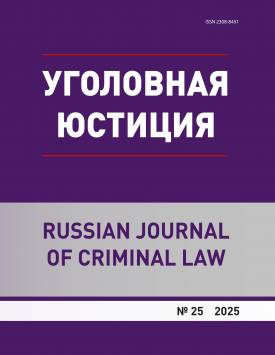Criminal law assessment of social dangerousness of a person who has committed a crime
The article states the tendency to expand the criminal law assessment of social dangerousness of a person who has committed a crime in the current criminal legislation. The social dangerousness of the guilty person is taken into account in the following contexts: during sentencing (Articles 60-89 of the Criminal Code); as a mitigating and aggravating circumstance (Articles 61, 63 of the Criminal Code), as a factor considered by the court when assigning a type of correctional institution to a convicted person (Article 58 of the Criminal Code); when imposing other types of punishments; when the perpetrator is released from criminal liability and punishment (Chapters 11, 12 of the Criminal Code of the Russian Federation), when the criminal record is removed (art. 86 of the Criminal Code of the Russian Federation); when applying criminal law measures other than criminal punishment (compulsory medical measures and others), when recognizing personality traits as a sign of a crime. The author criticizes legislative constructs that treat the repeated commission of an offense-after prior administrative punishment for a similar violation-as a crime, and that establish criminal liability based solely on a person's status as a leader in the criminal hierarchy (Article 210.1 of the Criminal Code of the Russian Federation). The authors declare no conflicts of interests.
Keywords
criminal's personality, social dangerousness of person who has committed crime, dangerous condition, nature of social dangerousness, degree of social dangerousnessAuthors
| Name | Organization | |
| Shesler Alexander V. | Kuzbass Institute of the Federal Penitentiary Service of Russia; Tomsk State University | sofish@inbox.ru |
| Shesler Sofya S. | Tomsk State University of Control Systems and Radioelectronics | sofish@inbox.ru |
References

Criminal law assessment of social dangerousness of a person who has committed a crime | Ugolovnaya yustitsiya – Russian Journal of Criminal Law. 2025. № 25. DOI: 10.17223/23088451/25/4
